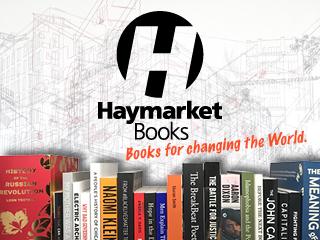Labor Day belongs to workers
tells the hidden history of Labor Day, in an article published at Jacobin.
FOR MOST Americans, Labor Day marks a change in the seasons: Summer has ended, football is about to begin, and millions of students return to school. Celebrations consist of taking advantage of deep discounts on patio furniture and mattresses.
Not that there's much political enthusiasm for Labor Day on the left, either.
Many depict it as a tokenistic "gift" from capitalist politicians who wanted a sanitized May Day that could capture militancy and disperse it into "responsible" channels. This narrative calls Labor Day a "bosses' holiday" that marks the working class's historic defeat.
This not only misrepresents the day's history, but also forces us to choose one holiday over the other, as if there were not enough room on the calendar for two days that celebrate workers.
May Day undoubtedly belongs to us: It symbolizes internationalism and solidarity. But Labor Day also has roots in our radical tradition. The militant struggles of the 1880s produced both holidays, and Labor Day's proponents also fought for the eight-hour day.

However, as the labor movement evolved--fracturing across different social layers and political tendencies--the holidays took on different meanings. Labor Day now stands for the working class's capture by conservative politicians, while May Day became synonymous with revolutionary action.
But those who see Labor Day as a sop to "buy off" workers gloss over the holiday's positive effects and the struggles of those who fought for it. The workers' movement and the socialists so integral to its early days created Labor Day. It did not begin as a national holiday, but as self-activity in the streets.
THE END of the 19th century was shattered by economic volatility and recurrent crises. The years following the Civil War saw a massive investment in Northern industry. Capital restructuring gave rise to factory production and monopolies.
New production techniques radically reshaped relations on the shop floor. Craft workers simultaneously enjoyed greater power and suffered from increasing levels of exploitation. Mechanization had begun in earnest, and skilled work was being replaced with a simplified division of labor. In this context, the working class was drawn to fledgling social-democratic movement.
Mass immigration injected a constant stream of labor power into the job market. These immigrants--hundreds of thousands a year--formed ethnic enclaves, established their own labor organizations, and contributed to a constantly changing working-class culture. Many brought social-democratic politics with them; others gravitated toward it thanks to the miserable conditions in American factories and cities.
Other struggles found hope in labor's militancy. The collapse of Reconstruction took back many of Black Americans' social, political, and economic gains and allowed new forms of institutional racism to develop. The fight for women's suffrage--spurred by emancipation--was temporarily defeated. This all translated into struggle, and the last decades of the nineteenth century erupted into strikes, riots and mass protest.
Most historical depictions of Labor Day begin when Grover Cleveland sanctioned a federal holiday in 1894; hence the claim that Labor Day has "conservative roots."
In reality, however, Labor Day started 12 years earlier--even before the 1886 Haymarket events that inspired May Day--with a mass rally in New York. On September 5, 1882, socialists, the Knights of Labor, and various left organizations associated with the Central Labor Union (CLU) organized a march calling for shorter hours, higher pay, safer working conditions--and a labor holiday. That year, New York had been the scene of spirited labor struggles. On January 30, thousands of workers thronged Cooper Union to support Irish tenants protesting their British landlords.
Notable labor agitators gave speeches, but two names on the roster loom largest: Peter McGuire, general secretary of the Brotherhood of Carpenters and Joiners, and eventual co-founder of the AFL; and Mathew Maguire, International Association of Machinists member and leader of the CLU. Both belonged to the same branch of the Socialist Labor Party (SLP), which was created in 1877, as the successor to the Social Democratic Workingmen's Party.
HISTORIANS STILL debate who initially demanded a labor holiday. But the CLU appointed a committee to organize the mass demonstration, and on September 5, 10,000 workers took an unpaid day off and marched from City Hall through Union Square to 42nd Street.
This event would soon become annual, spreading to other cities, states and municipalities as the movement for a labor day grew. In 1885 and 1886, various American cities declared the first Monday in September to be a workers' holiday, and on February 21, 1887, Oregon became the first state to recognize Labor Day. Massachusetts, Colorado, New York, and New Jersey followed later that year.
The activists who participated in and helped organize these early rallies also fought for the eight-hour day. Without that struggle, a labor holiday providing eight paid hours off was unthinkable. In fact, the slogan so synonymous with May Day--"Eight hours for work, eight hours for rest, and eight hours for what we will"--appeared on banners at the first Labor Day demonstration in 1882.
But it wasn't until 1894 that Grover Cleveland, a conservative Democrat, declared Labor Day a federal holiday. Not coincidentally, his announcement came at the close of a mass strike.
In June of that year, workers who built Pullman railroad cars had joined Eugene Debs's American Railway Union (ARU). They were angry that their steep pay cuts were not matched by rent reductions in their company town. As a result, 125,000 railroad workers refused to move any trains that had a Pullman car attached to it.
Cleveland called out the National Guard to police the railways but could not convince the strikers to resume work. Claiming that it was interfering with the postal service, Richard Olney, former attorney general, forced the courts to issue the first federal injunction against a strike.
When Debs refused to call the work stoppage off, he was jailed for six months. At least 30 workers were killed during the government's violent suppression of the strike. This violence was openly condemned by New York's Central Labor Union, who stood in full solidarity with the ARU.
Six days after it ended, Cleveland made Labor Day a national holiday, hoping it would defuse class anger and deflect attention away from the more militant May Day. But the president had other concerns too. It was a midterm election year, and Cleveland--serving his second nonconsecutive term--did not want to appear an enemy of organized labor. Yet he miscalculated: legalizing Labor Day could not make up for smashing the Pullman strike and jailing Debs. He lost his re-election campaign, and the labor movement didn't stay quiet for long.
Cleveland did not simply invent Labor Day, as we are often led to believe. The holiday represents a partial victory that reflects the labor movement's strength, which pressed its weight on the scales of politics and forced a federal reform.
Like most reforms, it had a dual character: on the one hand, it absorbed and nullified some worker militancy; on the other, it ceded ground to the unions and put them in a better position to win future demands. Seeing it merely as a weapon instituted from the top down obscures the class struggle that led directly to its adoption.
SINCE THEN, the holiday's vibrancy has risen and fallen with the labor movement.
Early Labor Day rallies helped build working-class culture, and had all the dynamism of a general strike: workers marched under unfurled red flags, sang labor songs, and heard incendiary speeches from the labor radicals of the day, including Eugene Debs. It faded in the twenties, but was revived in the thirties, when, for example, the CIO's Steel Workers Organizing Committee led a Labor Day march on Jones & Laughlin Steel during the 1937 Little Steel strike.
The movement waned again but the PATCO, Staley, Caterpillar, and Hormel strikes--infused with an urgent sense of solidarity--regenerated the holiday in the 1980s and '90s.
Further, Labor Day has turned into the conservative labor holiday because of the movement's political trajectory. In 1886, the AFL's creation allowed trade-union bureaucrats--disconnected from the workplace and invested with special privileges--to gain more control over the movement. This cut out the craft-worker socialists who had originally played a major role in not only the fight for a labor holiday, but also for shorter hours, fairer pay, and better working conditions. Moreover, when the Knights of Labor collapsed, workers lost an effective counterweight to craft elitism. This played a decisive role in the right turn of figures like McGuire.
Labor Day became the property of Samuel Gompers and the AFL: it was popularly associated with nationalism and anti-radicalism. But crucially, none of this appeared in the holiday's nineteenth-century history.
If today Labor Day has become a depoliticized, corporate and generic ritual, this fact proves that capital is winning. Labor Day would likely regain its old spirit with a new eruption in labor militancy.
We shouldn't base our assessment of the holiday on an unbalanced retelling of its history; we should honor its real origins and meaning. The best parts of Labor Day should be reclaimed, and its lessons distilled for workers and the left.
We can accommodate two labor holidays; one for the Haymarket martyrs, and one for the fallen at Pullman.
First published at Jacobin.


